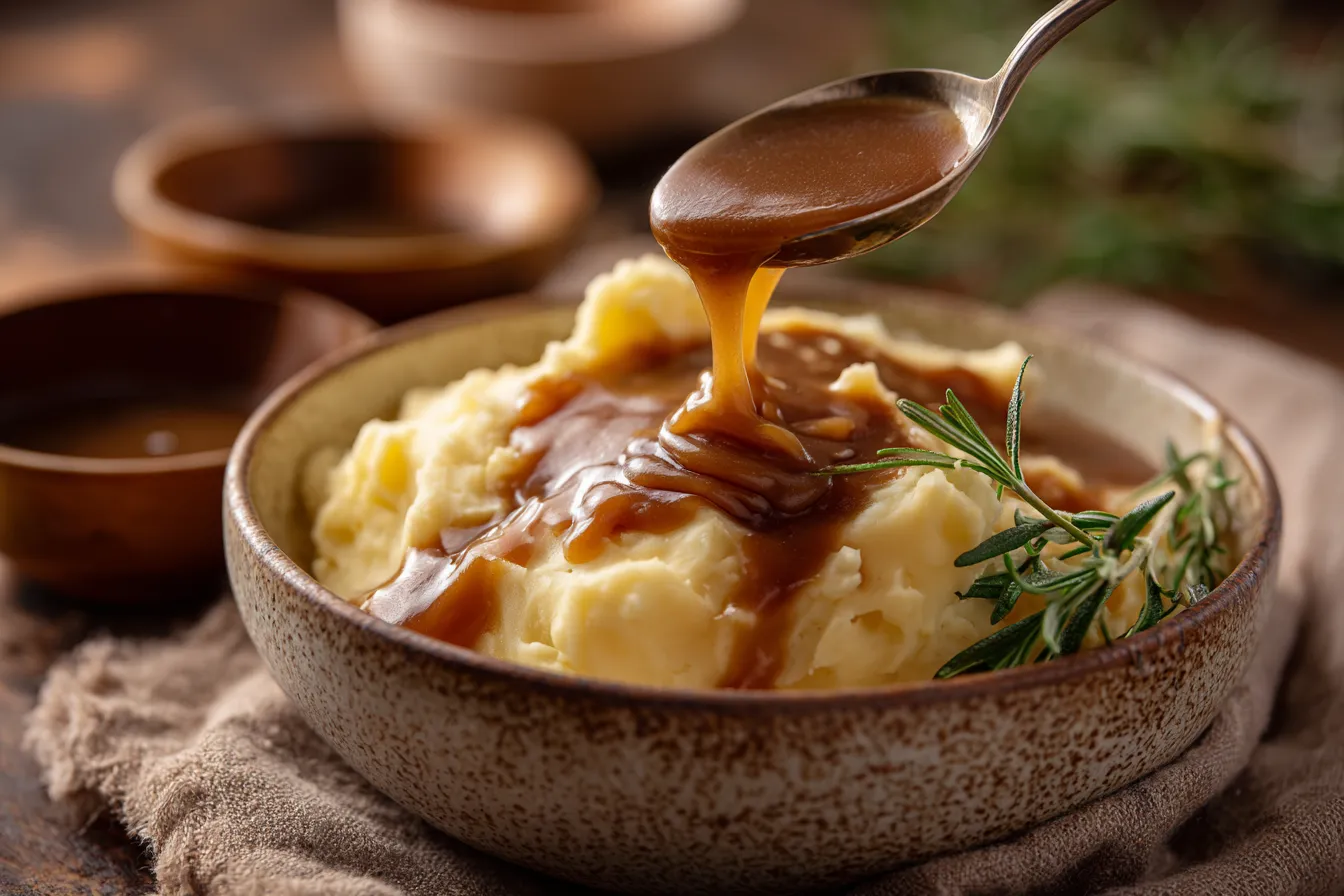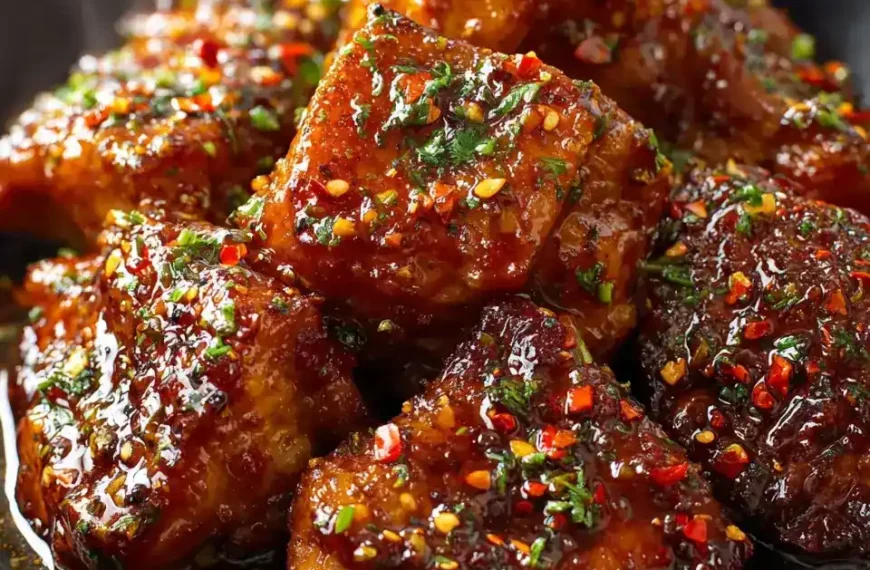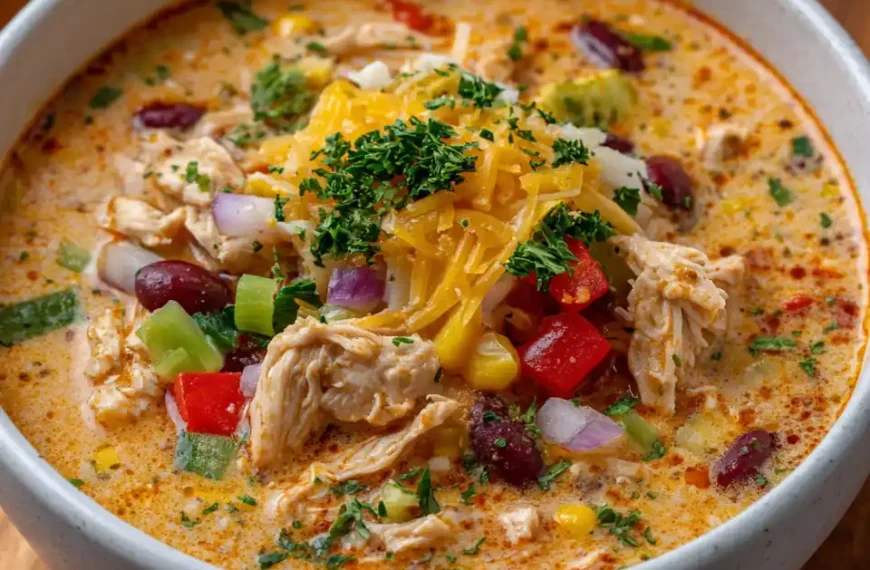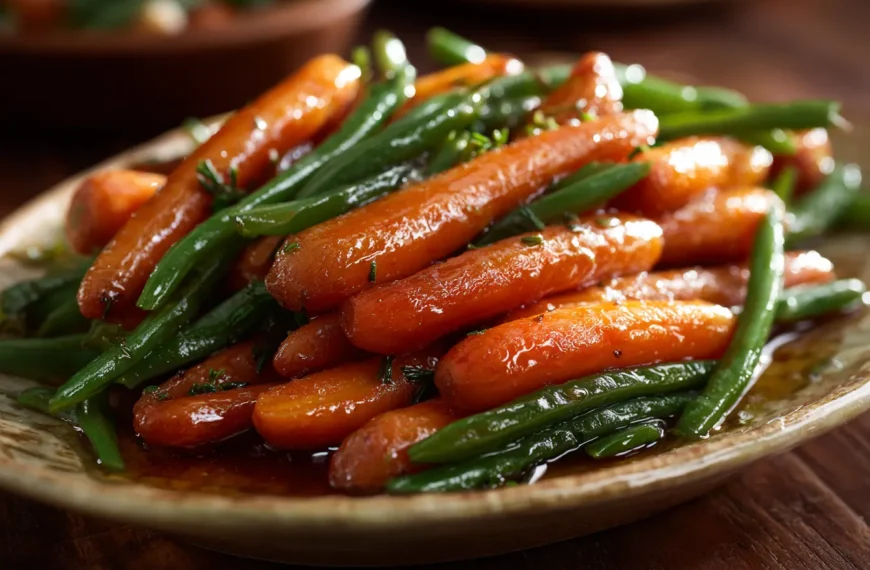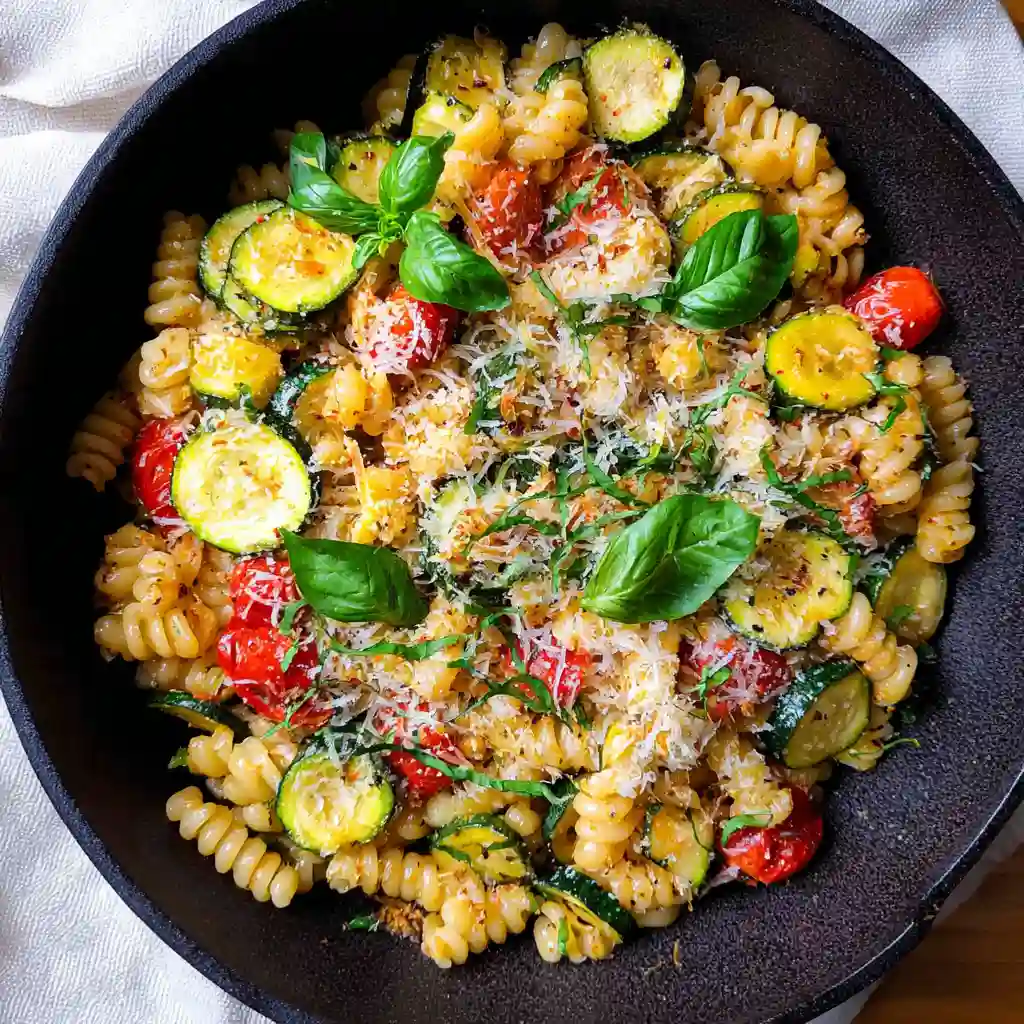Intro
Brown gravy doesn’t have to be complicated. In fact, this brown gravy recipe delivers deep, restaurant-style flavor in just 10 minutes—without any meat drippings at all. It came about during one chaotic Thanksgiving when the turkey was taking forever and the mashed potatoes were already cooling. No pan drippings? No problem. A little creativity and a few pantry staples turned into a gravy so rich, no one noticed the difference. Now, it’s a go-to any night of the week. Whether for weeknight comfort food or a holiday feast, this homemade gravy stands on its own—bold, savory, and unbelievably smooth.
Why This Brown Gravy Recipe Works Without Drippings
The Pantry-Based Gravy That Delivers
Not everyone has the luxury of fresh pan drippings every time they want gravy. That’s why this brown gravy recipe is designed to work without them. Instead, it layers flavor using everyday ingredients you likely already have: chicken broth, beef broth, a bouillon cube, and a few choice seasonings.
The combination of chicken and beef broth gives it a well-rounded, complex base. A cube of beef bouillon boosts that meaty flavor, making up for what would normally come from drippings. And those little things—like a touch of Worcestershire sauce and a drop or two of browning sauce—create the kind of depth people expect from something that simmered all day.
The best part? You control every element. No guessing if the drippings will be too salty, greasy, or bland. This recipe gives you consistency and bold flavor every single time.
The Secret to That Deep Color and Velvety Finish
The secret sauce here is actually two things: Kitchen Bouquet (or Gravy Master) and cold unsalted butter at the finish. While browning sauces aren’t essential, just a couple of drops give the gravy that classic dark, glossy appearance. It’s purely cosmetic—but presentation matters, especially when serving guests.
But it’s the butter at the end that takes this brown gravy recipe from good to elegant. Swirling in a tablespoon of cold butter off the heat smooths out the texture and adds a silky mouthfeel that mimics the best restaurant gravies. It’s a simple, pro-level trick that makes all the difference.
Mastering the Texture of a Perfect Brown Gravy Recipe
Thickening Techniques That Never Fail
A good brown gravy recipe should coat the back of a spoon without turning into paste. That texture depends on two things: how you thicken it and when. In this version, cornstarch and cold water form the thickening duo. They mix into a quick slurry, shaken together until smooth and lump-free.
Here’s the key: add the slurry after the broth comes to a boil. That higher temperature activates the cornstarch instantly, giving the gravy its body within seconds. Once it thickens, lower the heat right away and let it simmer gently. This step prevents over-thickening and allows the flavors to meld without boiling out the richness.
Cornstarch delivers a glossy, translucent finish. If you prefer a more opaque, roux-style look, you can swap in a butter-flour mixture at the start instead. But cornstarch keeps things fast—and it works beautifully every time.
Common Mistakes to Avoid With Gravy
Even the best brown gravy recipe can go sideways if a few simple things get overlooked. The first? Skipping the cold water in the slurry. If the cornstarch meets heat too early, it clumps and ruins the texture. Always shake it in a sealed container to keep it smooth and mess-free.
Next, don’t rush the simmer. After adding the slurry, give the gravy a few minutes on medium-low heat. That’s when the seasonings bloom, and the thickness evens out. If you skip this step, the texture can feel chalky or thin.
And finally—don’t forget the butter. That last swirl of cold, unsalted butter adds more than just shine. It rounds out the flavor and gives the gravy a luxurious finish. It’s not optional—it’s what makes this recipe stand out.
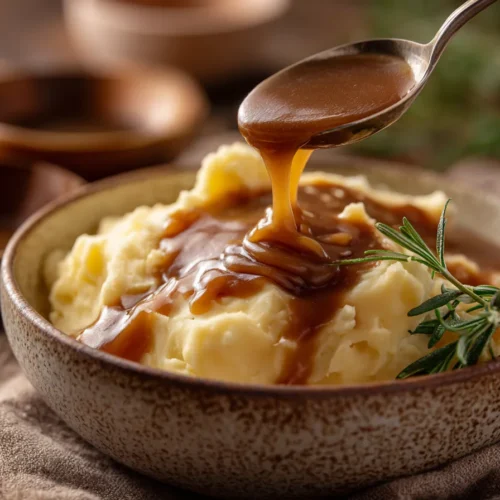
Brown Gravy Recipe
Ingredients
- 1 cup chicken broth
- ▢1 cup beef broth
- ▢1 cube beef bouillon or 1 tsp better than bouillon
- ▢1 teaspoon onion powder
- ▢½ teaspoon garlic powder
- ▢1 ½ teaspoons Worcestershire sauce can sub soy sauce
- ▢2-3 drops Kitchen Bouquet browning and seasoning sauce optional. Can also use Gravy Master.
- ▢1/4 cup cold water
- ▢3 tablespoons cornstarch
- ▢1 Tablespoon cold unsalted butter
Instructions
- Add the chicken broth, beef broth, beef bouillon, onion and garlic powder, and Worcestershire sauce to a medium saucepan. Stir to combine.
- Optional: If a darker color is desired, add 2-3 drops of Kitchen Bouquet browning and seasoning sauce. (Gravy Master works well too.)
- Combine the cold water and cornstarch in a small Tupperware with a lid. Shake to combine.
- Bring gravy to a boil. Whisk in cornstarch mixture. Allow gravy to thicken, then decrease to medium-low.
- Let it gently simmer for 2-3 minutes, or until your desired thickness and concentration is obtained.
- Remove from heat. Swirl in one tablespoon cold butter just before serving. This adds a silky, velvety finish.
Notes
If you have drippings: Add them in along with the beef and chicken broth, which will give you even more gravy. You can also measure out your drippings and top it off with enough broth to make 2 cups total. Bouillon may not be needed if drippings are being used—taste first and add if necessary.
This recipe is in The Cozy Cookbook on page 238!
Optional Ingredient Additions
Sautéed onions, Shallots, and/or mushrooms. Sauté at the beginning, then add broth, etc.
Fresh Rosemary, Sage, and/or Thyme. Add at the end of cooking.
A splash of Dry Red Wine. Add with the broth.
A pinch of Dijon Mustard.
Ground Pepper. Nutrition Calories: 69kcal, Carbohydrates: 9g, Protein: 1g, Fat: 3g, Saturated Fat: 2g, Cholesterol: 8mg, Sodium: 702mg, Potassium: 97mg, Fiber: 1g, Sugar: 1g, Vitamin A: 87IU, Vitamin C: 4mg, Calcium: 7mg, Iron: 1mg
Flavor Boosts and Creative Variations for Brown Gravy
Chef-Inspired Add-Ins You’ll Want to Try
Once you’ve mastered this brown gravy recipe in its basic form, it becomes the perfect blank canvas for bold, flavorful upgrades. With just one or two extra ingredients, you can easily tailor it to suit different meals—or impress guests who think it came from a fine dining kitchen.
Mushrooms are a great place to start. Sauté a handful of sliced button or cremini mushrooms in a bit of butter before adding the broth. They lend an earthy richness that deepens the entire dish. Want something even more aromatic? Add finely diced shallots or onions at the same stage. Cook them until golden and soft to create a naturally sweet base layer.
A splash of dry red wine also transforms the flavor. Just add it in with the broth and simmer for a minute to cook off the alcohol. The wine brings depth and subtle acidity, perfect for pairing with red meats. If you’re looking for a sharp finish, a pinch of Dijon mustard adds brightness without overpowering the savory foundation.
These little tweaks elevate the classic brown gravy without making it complicated. You’re still working with a fast, no-drippings recipe—but one that can shift from weeknight to gourmet in minutes.
Fresh Herbs That Add a Finishing Touch
Just before serving, fresh herbs can make your gravy smell as good as it tastes. A sprig of rosemary gives it a piney aroma that works well with roasted pork or lamb. Thyme adds subtle earthiness, while a few leaves of fresh sage introduce a warm, peppery note.
Stir herbs in during the last minute of simmering, or use them as a garnish if you prefer a more delicate infusion. They don’t just enhance the flavor—they add a pop of color that looks beautiful on the table.
These additions turn a simple brown gravy recipe into something unexpectedly special—proof that great food doesn’t need to be complicated, just thoughtful.
Serving, Storing, and Using Brown Gravy the Smart Way
How to Serve Brown Gravy Beyond Mashed Potatoes
While mashed potatoes are the classic companion to any brown gravy recipe, this sauce deserves a bigger role on your plate. It adds richness, moisture, and flavor to so many comfort food favorites—don’t limit it to just one.
Serve it over meatloaf for a nostalgic touch, or spoon it onto roast beef sandwiches for a diner-style meal at home. It also works wonders with chicken-fried steak, pork chops, or even pan-seared turkey cutlets.
Don’t overlook using it in casseroles either. Drizzle it into a shepherd’s pie before adding mashed potatoes, or use it as the sauce base for a hot roast beef open-face sandwich.
And here’s a little-known trick: serve leftover gravy over biscuits for a savory breakfast twist, or mix it with shredded roast meat for an easy filling in wraps or sliders.
With just 10 minutes and a handful of ingredients, you’ve got a sauce that ties together dozens of dishes.
Storing and Reheating the Right Way
If you have leftovers, this brown gravy recipe keeps well in the fridge for up to 4 days. Let it cool, then pour it into an airtight glass container or a small mason jar. When reheating, avoid the microwave if possible—stovetop heat brings it back to life without breaking the texture.
Place the gravy in a small saucepan over low heat. Stir occasionally until it loosens and reaches the right consistency. If it thickened too much in the fridge, add a splash of broth or water, one tablespoon at a time, until it smooths out.
You can even freeze this gravy. Let it cool completely, then freeze in a sealed container or ice cube tray. Thaw in the fridge overnight, then reheat on the stove. It stays flavorful, silky, and ready to serve.
Whether you’re prepping ahead for a big meal or saving leftovers for a quick lunch, this recipe holds up—and tastes just as great the second time around.
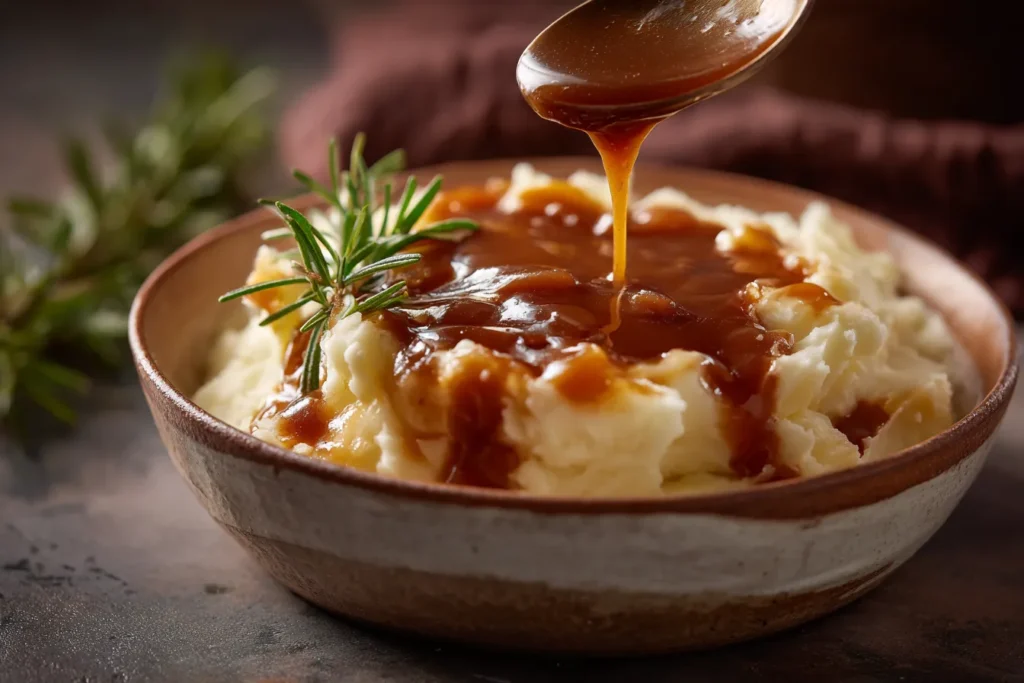
FAQs About Brown Gravy Recipe
1. Can I make brown gravy without beef broth?
Yes, you can use just chicken broth if that’s all you have on hand. The flavor will be slightly lighter, but still delicious. If you want to mimic the richness of beef, consider adding a small amount of soy sauce or a pinch of mushroom powder to deepen the taste.
2. What if I don’t have cornstarch—can I use flour?
Absolutely. Instead of making a slurry, create a simple roux by melting butter and whisking in an equal amount of flour. Cook for 1–2 minutes, then slowly add the broth while whisking. It’ll take a little longer to thicken but will work beautifully.
3. How do I fix gravy that’s too salty?
If your brown gravy recipe turns out too salty, add a splash of water or unsalted broth to dilute it. You can also stir in a teaspoon of heavy cream or a bit of plain mashed potatoes to help mellow the flavor without changing the texture.
4. Can I double this recipe for a crowd?
Yes, this brown gravy recipe scales up perfectly. Simply double or triple all ingredients. Make sure to taste and adjust the seasoning as you go. Use a larger pot and allow a bit more time for it to thicken evenly.
Conclusion
This brown gravy recipe proves you don’t need drippings to make something rich, flavorful, and deeply satisfying. With a few pantry ingredients and ten minutes on the stove, you’ll have a silky sauce that pulls any meal together. Whether it’s Sunday dinner, a holiday roast, or weeknight meatloaf, this is your go-to gravy that always gets compliments.
Thanks to easy swaps and optional upgrades, it’s a recipe you can rely on and reinvent—without stress, guesswork, or waste. So the next time your mashed potatoes need something special, skip the packet and stir up something real.
